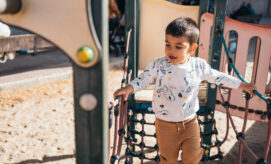Early childhood educators know that one of the most critical outcomes of their work with young learners is kindergarten readiness. While many skills factor into kindergarten readiness, the ability to physically write is high on the list. In order to write, children must be able to properly hold writing utensils and successfully maneuver them on paper, using fine motor skills that are the product of years of practice, through play, creative activities, and encouragement from the adults in their lives.
In this article, we describe fine motor skill developmental stages, and suggest specific activities that will encourage young children as they attain the building blocks that will prepare them for the all-important skill of writing.
Defining Fine Motor Skills
First 5 California defines fine motor skills as concentrated, small, and precise movements in the hand, thumb, finger, and wrist. These skills are used in activities such as drawing, writing, and holding a spoon. Children also utilize these skills when they reach for and grasp objects with their hands.
Fine motor skills are not to be confused with gross motor skills, which involve using larger muscle groups in arms and legs. Gross motor skills allow children to do larger movements like crawling, walking, and jumping.
Developmental Milestones
Fine motor skill developmental milestones care a useful guide for curriculum planning. By looking at where children are, and what milestones they are expected to achieve in the near future, you can create an environment that offers approachable and fun activities for fine motor skill development.
When reviewing milestones and considering children in your care, it is important to remember that each child is different and developmental milestones are always approximate. It is normal and expected that some children progress more quickly while others achieve milestones at a slower rate.
Birth – 18 Months
The Children’s Hospital of Richmond shares the important milestones that children typically reach during their first two years of life. In the first six months, infants are able to hold a small object in their hands and will reach for and hold toys. By 10 months, infants can transfer objects from one hand to the other and start to pick up small foods such as cereal using the pincer grasp (picking items up using just the thumb and forefinger). After their first birthday and into the first year, children will begin to have more concentrated hand and finger movements that allow them to turn the pages of cardboard books, point with an index finger, and put objects in a container.
18 Months – 2 Years
The Children’s Therapy & Family Resource Centre shares that during toddlerhood, children will be able to build larger towers, with 4-6 blocks, and feed themselves using forks or spoons. Children will also be able to hold crayons and will start to scribble, and paint with a paintbrush. Toddlers are also able to take on more autonomy by turning and opening knobs, by pulling up large zippers to zip up their own backpacks or coats.
2 Years – 3 Years







